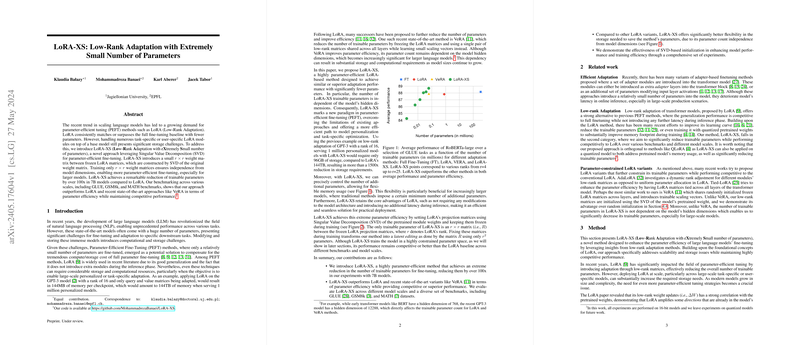LoRA-XS: Low-Rank Adaptation with Extremely Small Number of Parameters
The paper "LoRA-XS: Low-Rank Adaptation with Extremely Small Number of Parameters" addresses a critical concern in the field of NLP and, specifically, in the adaptation of LLMs. The proposed method, LoRA-XS, enhances parameter-efficient tuning approaches by significantly reducing the number of trainable parameters while maintaining competitive performance across various NLP benchmarks.
In recent years, the advent and scaling of LLMs have driven remarkable advancements in NLP. However, the sheer size of these models introduces extensive challenges, particularly when it comes to fine-tuning them for specific downstream tasks. Traditional fine-tuning methods necessitate updating a vast number of parameters, leading to substantial computational and storage demands. Parameter-efficient fine-tuning (PEFT) methods such as Low-Rank Adaptation (LoRA) emerged as viable solutions, significantly reducing the number of trainable parameters. Despite their success, even methods like LoRA face storage challenges, especially when handling large-scale personalized or task-specific models.
Methodology
LoRA-XS leverages Singular Value Decomposition (SVD) to address these limitations. The core idea involves constructing a small trainable weight matrix placed between frozen LoRA matrices, derived from the original pretrained weight matrix. This setup ensures that the number of trainable parameters is decoupled from the model dimensions, thus providing a substantial reduction in trainable parameters, by over 100x in specific cases. The LoRA-XS method comprises the following key steps:
- SVD-Based Initialization: The pretrained weight matrix
undergoes truncated SVD, decomposing it into matrices,, and. - Frozen Adaptation Matrices: The decomposition results in low-rank adaptation matrices
and, which are fixed during training. - Introduction of Trainable Matrix: A small
trainable matrixis placed betweenand, acting as the only trainable component, thereby significantly reducing the parameter count.
This novel approach not only improves parameter efficiency but also enhances flexibility, as the number of trainable parameters can be precisely controlled based on the downstream task requirements.
Experiments and Results
GLUE Benchmark
The paper evaluates LoRA-XS on the GLUE benchmark using the RoBERTa-large model and compares it against full fine-tuning (FT), LoRA, and VeRA. The results reveal that LoRA-XS with ranks ranging from 4 to 25 outperforms both LoRA and VeRA in parameter efficiency while maintaining high performance. For instance, LoRA-XS with a rank of 16 achieved superior accuracy over VeRA and LoRA, with a 2.5x and 30x reduction in trainable parameters, respectively.
Instruction Tuning
The method's efficacy in instruction tuning is also validated on the Mistral-7B and Gemma-7B models, focusing on the MetaMathQA dataset and evaluating on the GSM8K and MATH benchmarks. LoRA-XS demonstrated competitive performance to both full fine-tuning and LoRA, achieving this with a drastic reduction in trainable parameters. For example, LoRA-XS with only 0.92M parameters performed comparably to LoRA with 168M parameters on both benchmarks.
Ablation Study
An important aspect of the paper is the ablation paper comparing SVD-based initialization versus random initialization. The results underscore the benefits of aligning adaptation matrices with the top principal components of the pretrained weights. The SVD-based initialization not only led to better final performance but also accelerated convergence, particularly with smaller ranks.
Implications and Future Directions
LoRA-XS's implications are substantial for both theoretical and practical aspects of AI and NLP. The method addresses the scalability issue of PEFT methods by making trainable parameters independent of model dimensions, particularly beneficial for large-scale models. From a practical standpoint, this reduces the computational and storage overhead, paving the way for more efficient deployments of LLMs in real-world applications.
The theoretical implication lies in the innovative use of SVD for initializing adaptation matrices, suggesting a shift towards more informed initialization strategies in deep learning. Future research can explore extending LoRA-XS to other architectures and tasks, including reinforcement learning and multimodal models. Also, further studies could investigate the joint application of LoRA-XS with other memory-saving techniques like model quantization.
Conclusion
In conclusion, LoRA-XS presents a significant advancement in parameter-efficient fine-tuning. By leveraging SVD and introducing a minimal number of trainable parameters, it addresses the critical scalability and storage challenges faced by LLMs. The empirical results across various benchmarks and models highlight its efficiency and potential, marking a meaningful contribution to the field of NLP and model optimization.
